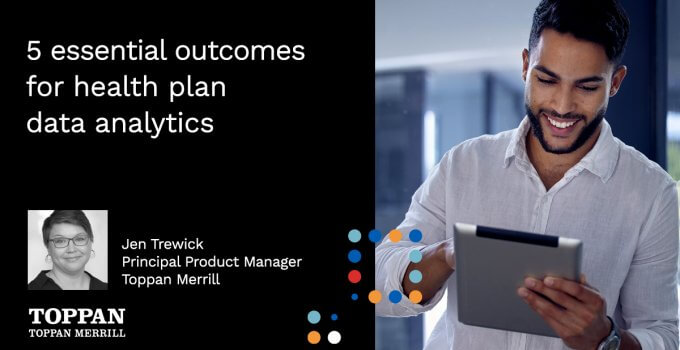Here’s a statistic you’ll want to share: The healthcare industry generates 30% of the world’s data volume today. In fact, healthcare data is growing faster than every other major industry, according to a 2023 report from the Healthcare Information and Management Systems Society (HIMSS). Health plans and other health insurance providers are a big part of this, inherently generating tremendous amounts of member data related to healthcare delivery, financial payments and member communications.
But while the HIMSS report finds that 9 in 10 healthcare leaders say using their data (through advanced analytics, machine learning and AI) is essential for driving organizational performance, almost half of all healthcare data is sitting idle, not driving business value.
Why? Because the sheer size of the opportunity in health plan data analytics can make it difficult to figure out where to start. Health plans can build a clear business case for analytics by identifying the specific use cases that align with health plans’ key business objectives.
Here are five ways that Medicare Advantage health plans should be using data analytics today to improve member experience, support member acquisition and improve operational performance:
1. Proactive interventions
By analyzing member health data, health plans can build predictive models to help identify members at higher risk of adverse health outcomes. These models can guide the development and delivery of proactive interventions—from preventive care and screenings, to care management programs and other targeted interventions, to mitigate risks and improve health outcomes. Health plans also can use real-time data streams from wearables, electronic health records or claims data for more acute interventions. These data streams can signal important changes in health status or adherence to care plans, and those changes can trigger proactive outreach, information and guidance on recommended preventive care and behavioral changes.
2. Quality improvements
Data analytics allows for a much better assessment of the quality of care delivered and identification of areas that need improvement. By analyzing clinical data, health plans can connect specific provider interactions with quality indicators like patient outcomes, adherence to clinical guidelines and rates of preventable complications. This makes it a lot easier to see the bigger-picture impacts of quality. Health plans can benchmark providers, facilities and care delivery networks to identify comparative variations in terms of quality metrics and quality outcomes. Health plans can also bring in—and even isolate—patient experience data from surveys, complaints and other patient engagement and satisfaction signals. This allows them to understand how patient preferences around how they receive communications, for example, can play a big role in shaping other quality metrics and outcomes.
3. Personalized member engagement
Health plans can use analytics to segment members in more sophisticated ways beyond demographics—including health status, care utilization patterns and other preferences. Much as with predictive modeling for health interventions, health plans can use member data to anticipate a full range of health and wellness needs, based both on a member’s life journey, specific health information and more real-time behavioral data. Perhaps most powerfully, health plans can use analytics to understand and deliver on each member’s unique preferences around communication channels and other alternate delivery formats (i.e., non-English, audio file, large print, etc.). This enables the health plan to create a fully personalized omnichannel experience, using digital channels like mobile apps, email and text alongside traditional channels like print and phone. The member gets the right information in the right channel—and the health plan sees better engagement, higher satisfaction and loyalty and reduced spend on ineffective communications.
4. Operational efficiency & cost management
Data analytics can inform better resource allocation to improve and reduce (or at least slow the increase in) the costs of services to members—a major concern right now for both health plans and consumers/members. Health plans can uncover key (often hidden) factors driving up costs—from clinical to administrative and even communications issues. The aforementioned predictive modeling drives more preventive care and targeted interventions that achieve the ideal of improving patient outcomes while reducing the total cost of care. Analytics also can help health plans root out fraud. Machine learning can detect unusual patterns, such as those around upcoding or billing for services not rendered. Finally, analytics insights can directly inform higher-level strategies around optimizing provider networks, allocating resources ranging from clinical staff to medical supplies, and even crafting better benefit packages tailored to deliver more of what members want (and utilize) most and less of what they don’t.
5. Supplemental benefit utilization enhancement
One very timely use case for health plan data analytics is to improve utilization of the supplemental benefits offered by most Medicare Advantage Organizations (MAO) today. This is a key focus of new CMS rules: Every MAO will need to implement a utilization management program to understand and increase utilization of these “fringe benefits.” But analytics will take these programs to the next level. Real-time utilization tracking can provide deeper insights into who is (and isn’t) utilizing supplemental benefits. Analytics also can identify patterns that predict higher or lower utilization, shaping strategies to influence member behaviors toward taking advantage of these benefits. Health plans also can do more detailed, continuous cost-benefit analyses to ensure they’re getting ROI on their supplemental benefits. And MAOs can leverage smarter segmentation and member profiling, based on analytics, to create and deliver more personalized, more relevant and ultimately more useful member communications that promote supplemental benefit utilization.
Taking the “crawl, walk, run” approach
After a decade of talking about digital transformation, the buzz in healthcare has shifted to AI. There is tremendous excitement across the business world around how AI will enable completely new levels of efficiency and fundamentally transform how organizations operate and interact with stakeholders.
For many health plans, it feels daunting to look at building an analytics and AI program from scratch. But as with all big changes, the key is focusing on small steps—taking the “crawl, walk, run” approach.
Building out a health plan data analytics program starts with creating a solid base of aggregated, “clean” data to work with. Then, health plans should identify the specific analytics use cases—like those mentioned above—that align with their top-level business objectives. This approach ensures that health plans can start realizing significant business value through their analytics applications today. With an established analytics program in place, health plans will have the launching pad they need to integrate the coming generation of AI tools and capabilities that promise to reshape the future of healthcare.
Toppan Merrill can help your health plan get started
Toppan Merrill helps health plans of all sizes and types to build and modernize member engagement programs that harness the power of their member data to drive more effective and efficient member communications. Our experts partner with you to identify the best use cases to maximize your member communications.
Learn more about Toppan Merrill Health Plans Member Communications



